Events:
August 24: Shorebirds of Florida's West Coast
Reminders:
August 5-11: The final count window for the Breeding Bird Protocol. If you're surveying a route with active nesting, weekly surveys help capture information about peak counts.
All Summer: Beach stewards are needed at important beach nesting sites. Check out the map of local stewardship opportunities and contact us to get involved!
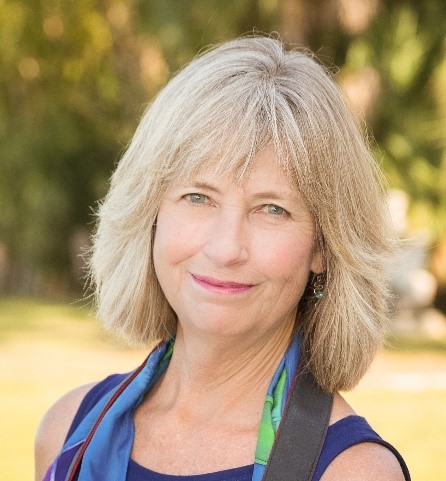
Partner Spotlight: Mary Lundeberg of the Charlotte and Lee County Shorebird Partnership
Mary Lundeberg, of the Charlotte and Lee County Shorebird Partnership, has dedicated her life to conservation through nature writing, photography and teaching. Mary grew up in Chicago, but lived most of her life in Minnesota, Wisconsin and Michigan, exploring the outdoors and kayaking whenever possible. After teaching K-12 reading in schools, she became a professor of education, so research and writing has always been a part of her career, along with a passion for educating people.
When Mary retired in Florida, her husband gifted her a digital camera to photograph ospreys, dolphins, shorebirds and the great horned owl nesting in Stump Pass Beach State Park. An accomplished nature writer and photographer, Mary uses photography and her long camera lens to provide people with the opportunity to view our adorable beach-nesting birds at a closer range.
Mary has always had a passion for nature and wildlife. She remembers being called to conservation when she was volunteering to test toxins in bald eagle chicks. The experience made her aware of the pollution entering our waterways, and how it not only affects wildlife, but humans as well. For the past eight years, Mary has enjoyed being at Stump Pass Beach State Park helping the rangers post areas for nesting Wilson’s plovers and least terns. She enjoys photographing the mating ritual of least terns and watching them fearlessly attack great blue herons, reddish egrets and humans, working together in groups to dive-bomb them. Mary loves how terns teach us that there is strength in numbers, and we need to fiercely protect what we love.
As a former Coastal Wildlife turtle patrol volunteer, she learned about the Suncoast Shorebird Partnership four years ago. She contacted Holley Short with Audubon Florida, and became a volunteer at Lido, Longboat Key and occasionally Siesta Key. This year, with the help of Audubon Florida, FWC, Carol McCoy and the Friends of Stump Pass, she began a Bird Steward program at Stump Pass Beach State Park to help protect nesting shorebirds. In just its first year, The Stump Pass Stewardship Program recruited 19 bird stewards, educated over 200 people and asked people to please remove 27 dogs from the beach!
The Florida Shorebird Alliance is so lucky to have a partner like Mary, who not only hits the beaches to educate and protect beach-nesting birds, but also uses her writing and photography to highlight the natural beauty of Florida. Thank you for your dedication to beach-nesting birds and Florida’s wildlife!
If you want to check out more about Mary’s work, visit her website at marylundeberg.com
(Photo: Deirdre Christman)
|
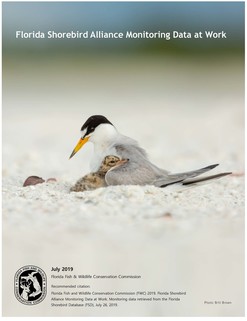
The 2019 FSA Monitoring Data at Work Annual Report is Here!
The 2019 “Florida Shorebird Alliance Monitoring Data at Work” annual report is hot off the presses and on the FSA website. Led by FWRI’s shorebird data team, the annual report presents monitoring data from 2011-2018 and summarizes how FSA monitoring data is used to measure progress toward conservation goals, identify information gaps, and adaptively manage for the long-term recovery of shorebird and seabird populations.
The revamped report features:
- Summaries of posting and monitoring effort
- Focal species minimum counts
- Rooftop nesting trends
- An example of the role of predation management in increasing productivity
- Focal species fact sheets
A huge THANK YOU to all of the shorebird monitors, stewards, and FSA partners. This report is a reflection of your hard work and dedication, and we are extremely grateful! Please email us with any questions.
|
Snowy Plover Chick Seek & Find
No peeking! Do you see the snowy plover chicks in the photo?
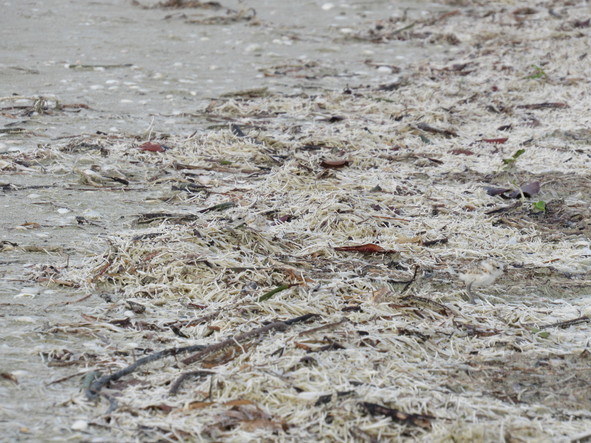 No? You're not alone. Snowy plover chicks are notoriously difficult to detect. Unable to fly after hatching, snowy plover chicks use camouflage as a primary survival strategy. The wrack line - the organic material deposited at high tide - allows plover chicks to hide from predators and feast on invertebrates found in the wrack, making it an important element of coastal habitats.
In addition to being difficult to detect, snowy plover chicks can be tricky to sort into age categories found in the Breeding Bird Protocol for Florida's Shorebirds and Seabirds. To assist monitoring partners in identifying age categories, the FSA recently published a Snowy Plover Aging Guide. The printable guide is a tri-fold format for ease of use in the field. The guide also features examples of the approximate age ranges for chick development under ideal conditions. The snowy plover aging guide is one of several chick aging guides available through the FSA website.
Need help finding the chicks? See below!
A big thanks to Audrey Albrecht of the Sanibel-Captiva Conservation Foundation for the cyrptic snowy plover chick photos.
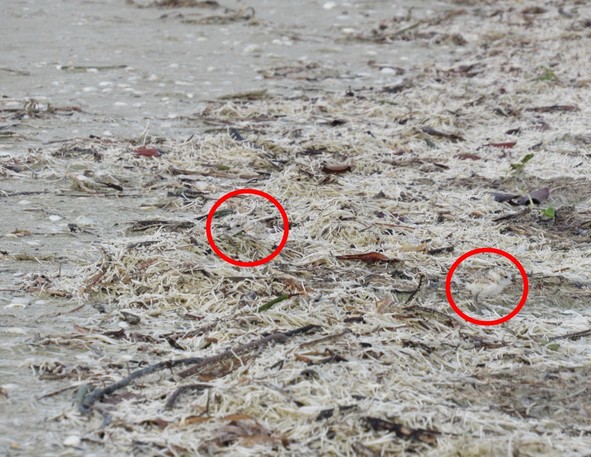

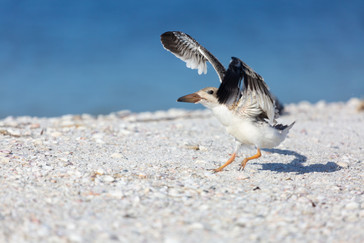
Late-season Chick Data is Important
August is the final count window for the Breeding Bird Protocol. Even though the breeding season is winding down, there is still valuable data to collect! Late season surveys capture important data, particularly about this year’s juveniles. Every time you record seabird chicks at a colony or observations of roving shorebird chicks and staging seabird young, we get information about where these young birds are spending time, how old they are, and how many adults are with them. This data is used to inform adaptive management and refine population estimates. Keep up the great monitoring work, everyone!
(photo: Britt Brown)
|
Gull-billed Tern Chick Adopted by Black Skimmers

Nassau Sound Islands Critical Wildlife Area, located in Little Talbot Island State Park, had an extraordinary nesting season this year with the first record of successful black skimmer nesting since 2012. This CWA protects multiple species including gull-billed terns and black skimmers nesting on a small corner of the sand spit on the north end of the park, formerly known as Big Bird Island. During monitoring efforts this season, Park Specialist, Allison Conboy, and FWC CWA Biologist, Kelsey Hamm, noticed a downy gull-billed tern chick begging from a black skimmer adult. Assuming it was exhibiting this behavior to all the adult birds in the colony, regardless of species, they shrugged off the observation.
|
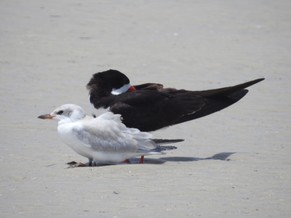
A few weeks later, the chick was fully flight capable and still shadowing two black skimmer adults! Game camera photos and direct observations revealed the black skimmers feeding and protecting “their” tern chick from other birds. The chick even adopted several of the black skimmer’s loafing quirks—tucking its bill behind its wing and lying flat on the sand. Unlike other tern species, gull-billed terns have occasionally been seen gleaning fish from the surface of the water—like a black skimmer’s feeding habits. Although Allison and Kelsey are not sure how this chick got its adoptive parents, they are confident it will be able to care for itself when fully fledged. (photos by Karen Parker)
|
|